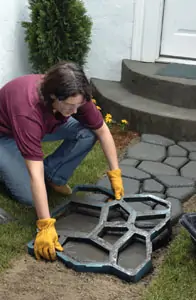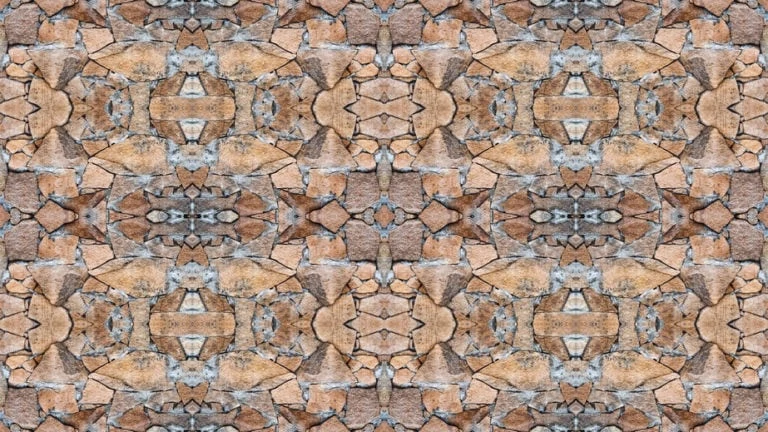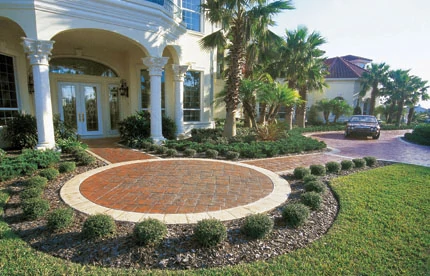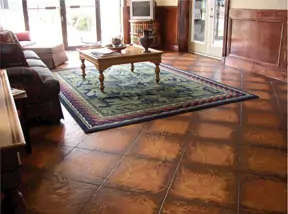Concrete has been used in construction since the Romans invented it about 2,000 years ago. Although it’s been a widely used material for driveways and sidewalks, it’s often seen as a dull and unremarkable option for homeowners in search of a distinctive look for their property. These days, however, driveways and walkways snaking through the front lawn don’t have to be a drab swath of gray. New textures, patterns and stains can be applied to give concrete a colorful and decorative edge that can actually enhance the look of your yard, garden, or indoor living area. From color additives to stamps and molds, new tools and products enable homeowners to boost the appeal of a concrete surface like never before.
Stains
Concrete is well known for being easy to stain. Those nasty driveway blotches left by automotive oil leaks, or discoloration from fallen tree leaves, attest to that. But modern technology offers the ability to choose when, where and what type of stain is applied to poured concrete. Imagine matching a brown home to a concrete path stained a light shade of brown. For red brick homes, red-stained concrete coupled with a brick-like surface pattern can simulate the look of a real brick patio.
The type stains that offer the boldest coloration actually bond chemically with the concrete. These chemicals bond with the carbon ions in concrete in a process called carbonation.
Other stain types simply deliver pigment to the open pores of the concrete. This is often a very effective method of coloring concrete, but the texture of the concrete surface affects how well this method works. For example, a slick, steel-troweled slab would be difficult to stain. In this case, the surface will have been tightly sealed by bringing the very fine cement particles to the surface with the trowel, and the pigment doesn’t have as many “handles” to grab to. On the other hand, rougher, broom-finished concrete allows the pigments a better surface to soak into and bond.
A true stain is a liquid material with color particles floating in suspension. The color particles are so small that when they soak into the concrete, they colorize it without hiding the natural grain.
Film-forming coatings are sometimes advertised as “stains” to decorate concrete. But these coatings actually form a film that lays on top of the concrete surface – meaning they are basically paints. The film often hides the true texture of the concrete, and may not offer the durability of a true stain.
If you’re pouring a new slab or walkway, dry color/hardeners are available that are powdered pigments mixed with fine silica. The powder is spread over freshly poured concrete and worked into the surface with bull floats and trowels. This method can colorize concrete to a depth of 1⁄8 inch or more. This is an ideal coloring method to couple with stamped or patterned surfaces.
Also, bear in mind that outdoor concrete surfaces are tougher to maintain than indoor areas, due to weather exposure. The best coloring option for areas subject to direct sunlight may be a concrete stain engineered with UV-resistant pigments that maintains its color for extended periods of time.
You can choose from three primary types of stains:
Acid and aniline stains – These stains produce a rich color, offering a marbled effect like that of grained leather. These are high-quality products but are probably the most costly choice and require great care in applying.
Solvent-based stains – similar to traditional wood stains, this type uses a hydrocarbon solvent to transport the stain deep into the concrete. Some solvent stains can change color over time. Be sure to ask your supplier about this if choosing this type of stain.
Water-based and acrylic-based stains – These types of stains are some of the newest technology. These are environmentally friendly and allow deep earth tones or bright pastels. With the proper surface preparation, these stains can be easy to apply for most homeowners.
In most cases, new concrete should dry or cure for 30 to 45 days prior to staining. And each stain is different, often requiring different tools and techniques. So always follow the manufacturer’s guidelines to the letter, and be mindful of all safety suggestions, especially when working with an acid- or solvent-based stain.
And remember – you’ve only got one chance with concrete stain. If you screw it up, you might be stuck with a bad art project. So if you’re new to the process and you’re considering staining a large driveway, you may want to hire a pro.
There’s also the option of ordering premixed colored concrete from your local supplier.
Textures, Patterns and Forms
One of the most popular ways to add some pizzazz to a concrete surface is to use a texturing pattern. After pouring new concrete into a properly compacted, formed and reinforced foundation, the slab is first finished in the conventional method. Then a color/hardener is added to the surface and troweled in. Next, a releasing agent is applied to prevent the mats or stamps from sticking to the concrete. The releasing agent can also be colored to achieve a darker look in the pattern’s “grout” lines. Before the concrete sets up, the stamping patterns, or “texture mats,” are tamped into place, imprinting any number of stone- or brick-like patterns.
Companies such as Increte Systems and Bon Tool offer these texturing systems. Available patterns include granite, slate, stone, brick and more.
Also available are stamped overlay systems to cover existing concrete surfaces. These overlays are applied 1⁄4 or 3⁄8 inch over the existing slab, and are actually designed to be stronger and more durable than concrete.
Flexible forming boards are also handy tools for creating decorative concrete. Flexible forming boards made from composite materials help to minimize the hassle associated with building curved wood forms. For example, ConcreteFormingBoard from FiberTech is designed to bend into circles as small as 24 inches without cracking, splitting or breaking. Flexible forms help to create smooth curves for winding garden paths and poolside walkways.
The Quikrete Company has combined the ideas of stamping and forming to offer the Quikrete Walk Maker, a family of reusable plastic molds designed to create brick- and stone-patterned features in concrete sidewalks, garden paths and patios. The Walk Maker is available in Country Stone, Running Bond Brick, European Block and Basket Weave patterns.

Application is fairly simple. After clearing and leveling the desired area, and preparing a mix of fiber-reinforced concrete, place the Walk Maker mold on the ground and completely fill the cavities with concrete. Use a trowel to smooth and even the surface before removing the mold. Continue the process by placing the mold at the end of the first application until reaching desired length. Detailed application directions are provided with the product.
Topping It Off
A variety of concrete sealers are on the market, which add a finishing touch to the concrete surface. You’ll notice a glossy finish on most textured concrete surfaces. The sheen is an indication of concrete sealer. Sealers come in a variety of “sheens” and play a vital role in protecting the concrete from stains, weather and scratching. Before applying a sealer to newly stamped concrete, wash off excess release agent with a pressure washer and allow the surface to dry. Once the sealer is applied and allowed to cure, you’ll have a striking new decorative surface that will catch the eye and last for years.





